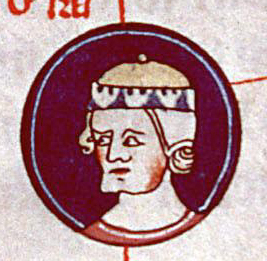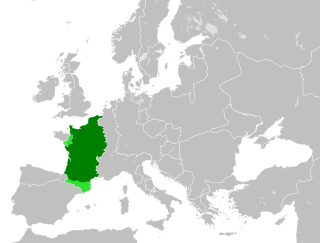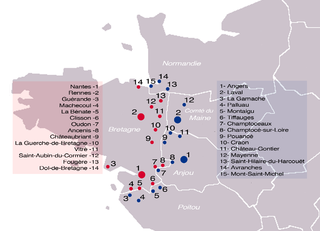Related Research Articles

Rollo was a Viking who became the first ruler of Normandy, a region in northern France. He emerged as the outstanding warrior among the Norsemen who had secured a permanent foothold on Frankish soil in the valley of the lower Seine. After the Siege of Chartres in 911, Charles the Simple, the king of West Francia, gifted them lands between the mouth of the Seine and what is now Rouen in exchange for Rollo agreeing to end his brigandage, swearing allegiance to him, religious conversion and a pledge to defend the Seine's estuary from Viking raiders.

Hugh Capet was the King of the Franks from 987 to 996. He is the founder and first king from the House of Capet. The son of the powerful duke Hugh the Great and his wife Hedwige of Saxony, he was elected as the successor of the last Carolingian king, Louis V. Hugh was descended from Charlemagne's sons Louis the Pious and Pepin of Italy through his mother and paternal grandmother, respectively, and was also a nephew of Otto the Great.
Charles III, called the Simple or the Straightforward, was the king of West Francia from 898 until 922 and the king of Lotharingia from 911 until 919–23. He was a member of the Carolingian dynasty.

Neustria was the western part of the Kingdom of the Franks.
Robert I, was the elected King of West Francia from 922 to 923. Before his election to the throne he was Count of Poitiers, Count of Paris and Marquis of Neustria and Orléans. He succeeded the overthrown Carolingian king Charles the Simple, who in 898 had succeeded Robert's brother, king Odo.

Hugh the Great was the Duke of the Franks and Count of Paris.
Rudolph or Rudolf was the king of France from 923 until his death in 936. He was elected to succeed his father-in-law, Robert I, and spent much of his reign defending his realm from Viking raids.
Flodoard of Reims was a Frankish chronicler and priest of the cathedral church of Reims in the West Frankish kingdom during the decades following the dissolution of the Carolingian Empire. His historical writings are major sources for the history of Western Europe, especially France, in the early and mid tenth century.
Richard I, also known as Richard the Fearless, was the count of Rouen from 942 to 996. Dudo of Saint-Quentin, whom Richard commissioned to write the "De moribus et actis primorum Normanniae ducum", called him a dux. However, this use of the word may have been in the context of Richard's renowned leadership in war, and not as a reference to a title of nobility. Richard either introduced feudalism into Normandy or he greatly expanded it. By the end of his reign, the most important Norman landholders held their lands in feudal tenure.

The treaty of Saint-Clair-sur-Epte (911) is the foundational document of the Duchy of Normandy, establishing Rollo, a Norse warlord and Viking leader, as the first Duke of Normandy in exchange for his loyalty to the king of West Francia, following the Siege of Chartres. The territory of Normandy centered on Rouen, a city in the Marches of Neustria which had been repeatedly raided by Vikings since the 840s, and which had finally been taken by Rollo in 876.

Tilpin, Latin Tilpinus, also called Tulpin, a name later corrupted as Turpin, was the bishop of Reims from about 748 until his death. He was for many years regarded as the author of the legendary Historia Caroli Magni, which is thus also known as the "Pseudo-Turpin Chronicle". He appears as one of the Twelve Peers of France in a number of the chansons de geste, the most important of which is The Song of Roland. His portrayal in the chansons, often as a warrior-bishop, is completely fictitious.

The Battle of Soissons was fought on 15 June 923 between an alliance of Frankish insurgent nobles led by Robert I, elected king in an assembly the year prior, and an army composed of Lotharingians, Normans, and Carolingian forces under King Charles III's command. The battle took place at Soissons, near Aisne. Robert was killed, but his army won the war. Charles was imprisoned by Herbert II of Vermandois and held captive until his death in 929. Rudolph, Duke of Burgundy, Robert's son-in-law, succeeded him as ruler of West Francia.

Fulk the Venerable was archbishop of Reims from 883 until his death. He was a key protagonist in the political conflicts of the West Frankish kingdom that followed the dissolution of the Carolingian Empire in the late ninth century.

Herbert II, Count of Vermandois, Count of Meaux, and Count of Soissons. He was the first to exercise power over the territory that became the province of Champagne.

In medieval history, West Francia or the Kingdom of the West Franks refers to the western part of the Frankish Empire established by Charlemagne. It represents the earliest stage of the Kingdom of France, lasting from about 840 until 987. West Francia emerged out of the partition of the Carolingian Empire in 843 under the Treaty of Verdun following the death of Charlemagne's son, Louis the Pious.
William Longsword was the second ruler of Normandy, from 927 until his assassination in 942.
Theobald I (913–975), called the Trickster, was the first count of Blois, Chartres, and Châteaudun as well as count of Tours.

The Marches of Neustria were two marches created in 861 by the Carolingian king of West Francia Charles the Bald that were ruled by officials appointed by the crown, known as wardens, prefects or margraves. Originally, one March was created against the Bretons and one against the Norsemen, often called the Breton March and Norman March respectively.
The Robertians are the proposed Frankish family which was ancestral to the Capetian dynasty, and thus to the royal families of France and of many other countries. The Capetians appear first in the records as powerful nobles serving under the Carolingian dynasty in West Francia, which later became France. As their power increased, they came into conflict with the older royal family and attained the crown several times before the eventual start of the continuous rule of the descendants of Hugh Capet.

Louis IV, called d'Outremer or Transmarinus, reigned as king of West Francia from 936 to 954. A member of the Carolingian dynasty, he was the only son of king Charles the Simple and his second wife Eadgifu of Wessex, daughter of King Edward the Elder of Wessex. His reign is mostly known thanks to the Annals of Flodoard and the later Historiae of Richerus.
References
- ↑ Schmitz, Gerhard (1978). "Heriveus von Reims (900-922). Zur Geschichte des Erzbistums Reims am Beginn des 10. Jahrhunders". Francia. 6: 59–105, at 61.
- ↑ Roberts, Edward. Flodoard of Rheims and the writing of history in the tenth century. Cambridge, United Kingdom. ISBN 978-1-316-51039-1. OCLC 1089282727.
- ↑ Hamilton, Sarah (2001). The Practice of Penance, 900-1050. Woodbridge: Boydell & Brewer. pp. 55–56. ISBN 0861932501.
- ↑ Hagger, Mark S. Norman rule in Normandy, 911-1144. Woodbridge, Suffolk, UK. ISBN 978-1-78744-023-4. OCLC 1085896754.
- ↑ Roberts, Edward (2019). Flodoard of Rheims and the Writing of History in the Tenth Century. Cambridge: Cambridge University Press. p. 116. ISBN 9781316510391.
- ↑ Koziol, Geoffrey (2012). The Politics of Memory and Identity in Carolingian Royal Diplomas: The West Frankish Kingdom (840-987). Turnhout: Brepols. p. 427. ISBN 9782503535951.
- ↑ Fanning, Steven and Bachrach, Bernard S. (2004). The Annals of Flodoard of Reims, 919-966. Peterborough, ON: Broadview Press. pp. 6–7. ISBN 978-1442600010.
| Catholic Church titles | ||
|---|---|---|
| Preceded by Fulk | Archbishop of Reims 900–922 | Succeeded by Seulf |